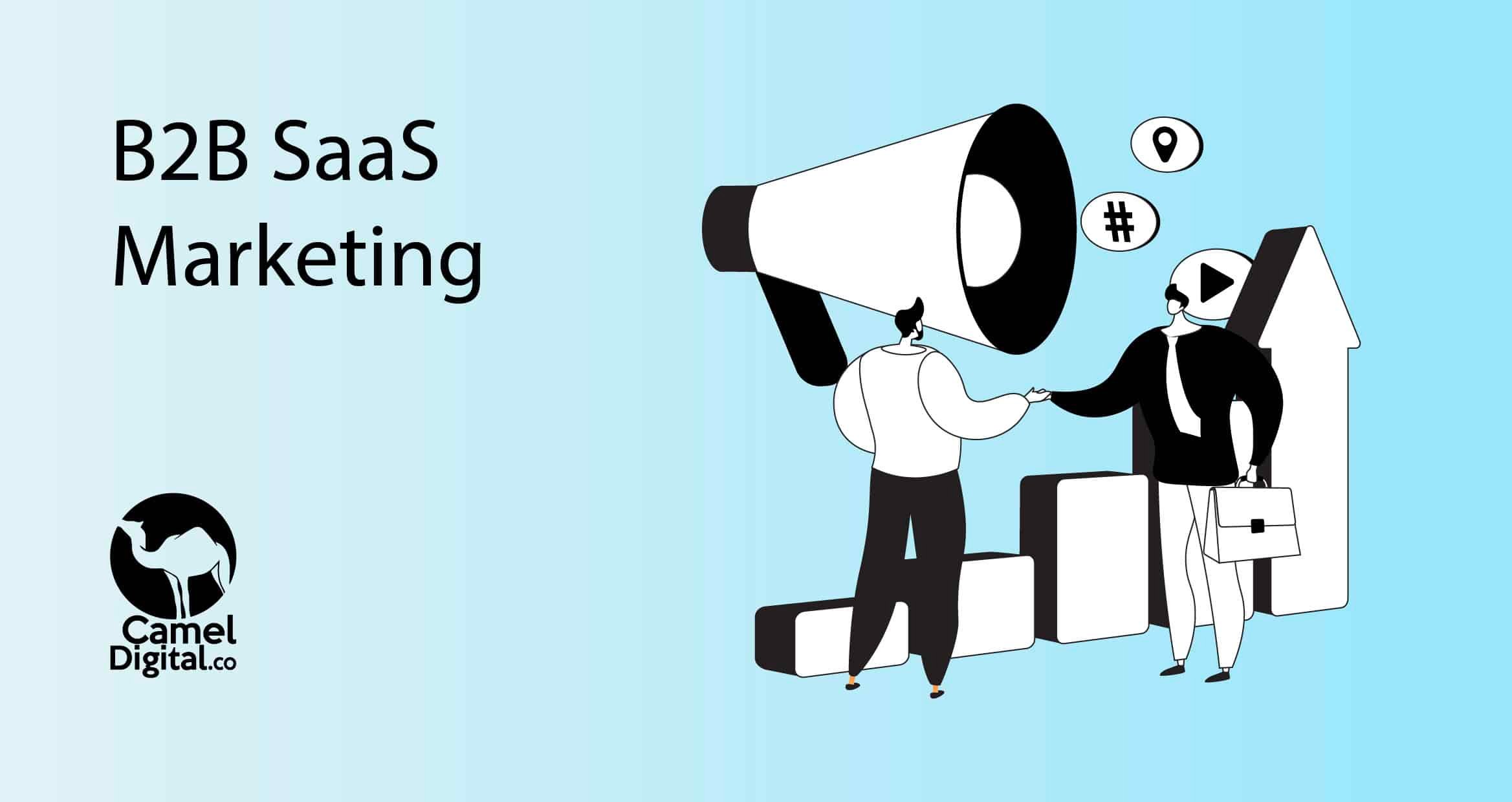B2B SaaS marketing is fiercely competitive. You either lead with truly unique software or compete in an overcrowded market offering similar features to the same limited audience.
Large players dominate thanks to massive budgets and Google’s preference for big names, leaving smaller companies struggling to stand out. Camel Digital, a specialized B2B SaaS agency, spent five years testing strategies to find what actually works.
In this article, we talk about what we found works best based on real-life examples.
What Is B2B SaaS Marketing?
One of the most saturated markets in the world, B2B SaaS marketing is a collection of efforts aimed at selling cloud-based, subscription software to businesses.
Because software is intangible and sold on a subscription basis, it requires recurring payments, marketers have the extra challenge of explaining why a business should keep paying month after month.
Considering the longer sales cycles in the B2B industry (around 2.1 months of median value), is a long time to keep potential customers interested, engaged, and moving forward toward a subscription.
The end goal of a B2B SaaS marketing funnel is paid subscriptions. Still, the steps leading there often include driving qualified traffic, generating leads, offering free trials, securing demos, and guiding potential clients toward purchase.
What’s Unique About the B2B SaaS Marketing Funnel? How to Make It Work?
Selling subscription software is very different from selling a one-time product. It’s easier to tell a buyer, “This product is $1,200,” than to convince them to pay “$100/month ($1,200/year)” for a contract that renews automatically unless they cancel.
In short, B2B SaaS marketing means selling something that requires continuous payments. That means your funnel must focus on building long-term relationships and giving ongoing reasons for customers to stay. It’s not a one-and-done deal like many B2C purchases.
Common SaaS Business Models and Their Marketing Implications
Attracting new B2B SaaS customers is challenging because the market is competitive, and just pitching a product with a price tag won’t cut it. The marketing approach will depend on your business model.
Below are the main B2B SaaS models and the most effective tactics for each.
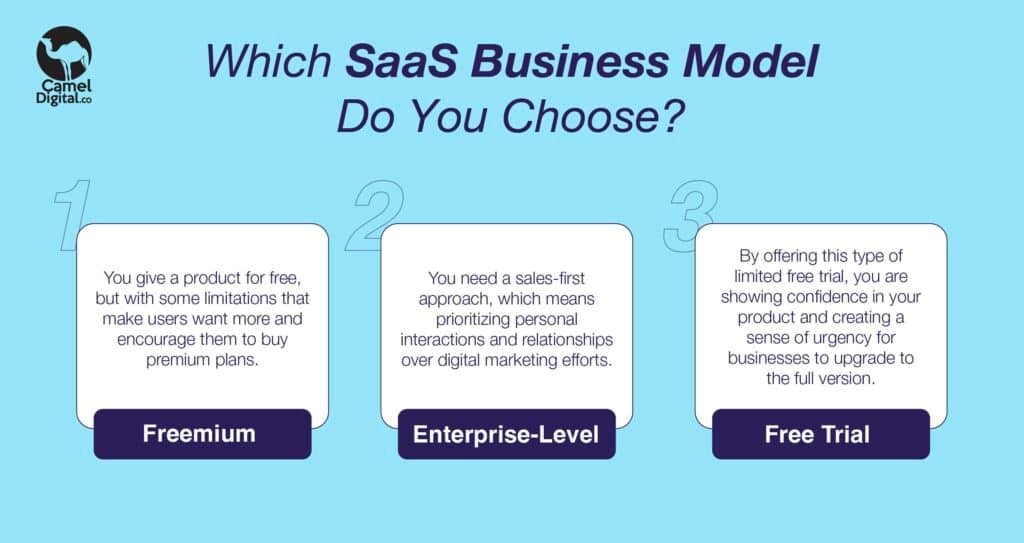
Freemium Software
Have you ever tried a free sample in a shop, liked it so you bought the full size product? Freemium is just like giving customers a free sample at a store. You provide a product for free with certain limitations, then encourage users to upgrade to access the full features.
For example:
- A free invoicing tool may allow users to create an invoice but require a premium plan to download it.
- A design platform might give access to part of the template library for free while keeping the best designs for paying customers.
The trick is to make the free version valuable enough that users enjoy using it, while making the premium version compelling enough that they feel motivated to upgrade. This model often works well with SaaS lead generation strategies that nurture users over time.
Enterprise-Level Software
Enterprise demo-based products focus more on relationships than on one-time software sales. You don’t need a universal SaaS that solves every problem. Instead, you build contact and trust while customizing the product.
For example, you can offer personalized demos and trials tailored to a prospect’s exact needs. By analyzing their business and demonstrating how your software addresses their specific needs, you position yourself as a partner, not just a vendor.
Many enterprise-focused companies take a sales-first approach, prioritizing human contact over automated marketing. Once your solution becomes deeply integrated into their workflows, it becomes very hard for them to replace you.
Limited Free Trial Software
In many SaaS companies, a free trial follows the same pattern. A user signs up, starts exploring the product, puts time into creating something useful, and begins to see its potential. Then the trial ends and everything stops unless they upgrade to a paid plan.
That sudden cut-off can push people away, even if they liked what they saw. A better approach is to let them keep access to a basic set of features once the trial is over, while keeping the more advanced tools behind the paid plan.
This keeps the connection alive. They continue using your product, building it into their daily routine, and seeing its value firsthand. Over time, the limitations of the free version make the premium features more appealing, and that gentle pull can be what tips them into becoming paying customers.
Core Branding and Messaging Principles
SaaS Brand Strategy for Long-Term Success

In B2C marketing, eye-catching visuals and clever taglines can quickly grab attention and influence buying decisions. Meanwhile, in B2B SaaS, the decision-making process is slower and more cautious, so your brand needs to be built on reliability, trust, and proven results.
In B2C marketing, eye-catching visuals and clever taglines can quickly grab attention and influence buying decisions. Meanwhile, in B2B SaaS, the buying process is slower and more cautious, so your brand must be built on reliability, trust, and proven results.
Because sales cycles are long, branding is not just about winning attention before a purchase. It is about delivering value and maintaining credibility after the sale. Customers often judge your product most closely during the first months of use, and their decision to renew will depend on that experience.
Showcase expertise, a strong track record, and excellent support. Consistent effort before and after the sale builds the trust needed for renewals, referrals, and long-term loyalty.
B2B SaaS Messaging That Converts
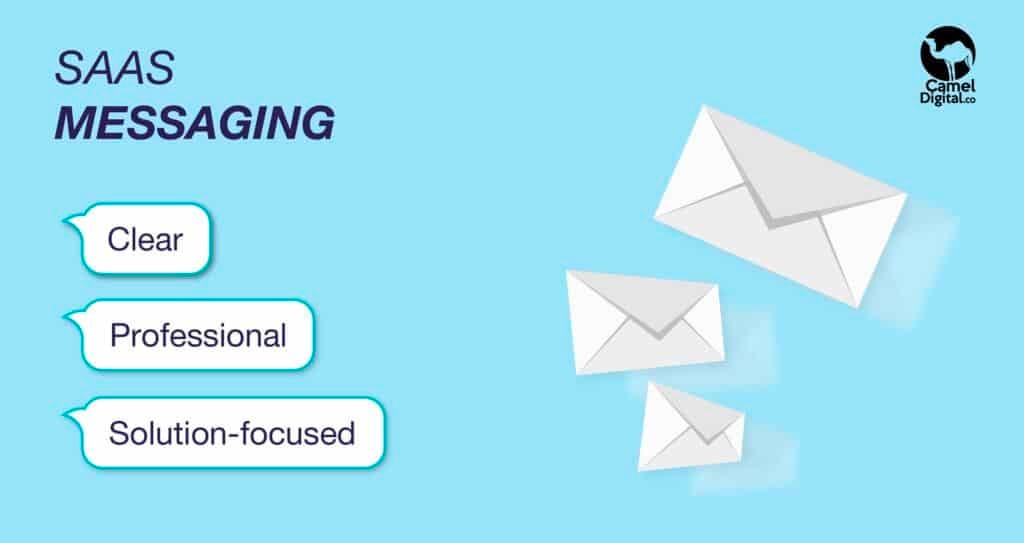
The way you speak to a general consumer is very different from how you address an experienced B2B buyer with specific goals and challenges. You cannot win over a CEO or department head with vague claims like “the best” or “the ultimate.”
B2B buyers want solutions that deliver real value. For example, “Organize your lead management and drive sales with our intuitive CRM software” is far more persuasive than “Get the best CRM at an affordable price.”
The most effective SaaS marketing campaigns target decision-makers with clear, professional messaging that focuses on measurable business benefits. Avoid a casual or gimmicky tone, and instead communicate genuine, tangible value. In 2025, messaging that combines clarity, proof, and relevance is what resonates with B2B customers.
The Best B2B SaaS Marketing Strategies in 2025
Most B2B SaaS marketers have limited budgets and resources, so every campaign decision counts. Spending without a clear plan can quickly drain funds, especially in a crowded market where larger competitors dominate search and ad placements.
At Camel Digital, our team has spent five years testing different strategies, investing millions in paid ads, and analyzing what works across various SaaS niches. We’ve found that the most effective SaaS campaigns in 2025 focus on precision and reaching the right people, with the right message, at the right moment in their decision-making process.
Below are 13 strategies that consistently deliver results, along with practical tips on how to adapt them to your own SaaS marketing budget and growth goals.
1. Have a Catchy Website and Conversion-Optimized Landing Pages
Your website is often the first real interaction a potential customer has with your SaaS. In 2025, a high-converting landing page is not optional, it is the core of your lead generation and sales funnel.
When someone clicks through from an ad or a search result, they should instantly understand what you offer, why it matters, and how to take the next step. That means clear headlines, concise copy, and an obvious call to action. Avoid clutter, distractions, or long-winded explanations.
A well-structured landing page can dramatically improve conversions and ultimately boost your ROI for SaaS marketing efforts.
The Best Structure for a Sales-Focused Landing Page
Hero section with a catchy headline, short product description, and clear CTA
Your headline should communicate the number-one value of your product, and your description should give the big picture in just a few sentences. Avoid generic or “fluffy” marketing text that says little but takes up space.
Social proof that builds trust
Use customer testimonials, reviews, ratings, and even statistics that show your product’s success. These elements reassure potential buyers that your solution works in the real world.
Key value propositions listed clearly
Identify 3–6 core value propositions (not just a list of features) that bring the most benefit to your clients. Too many extras can dilute your message and make your product seem unfocused.
Keep the design clean, the navigation minimal, and place your main call to action in multiple spots on the page so it’s always within reach.
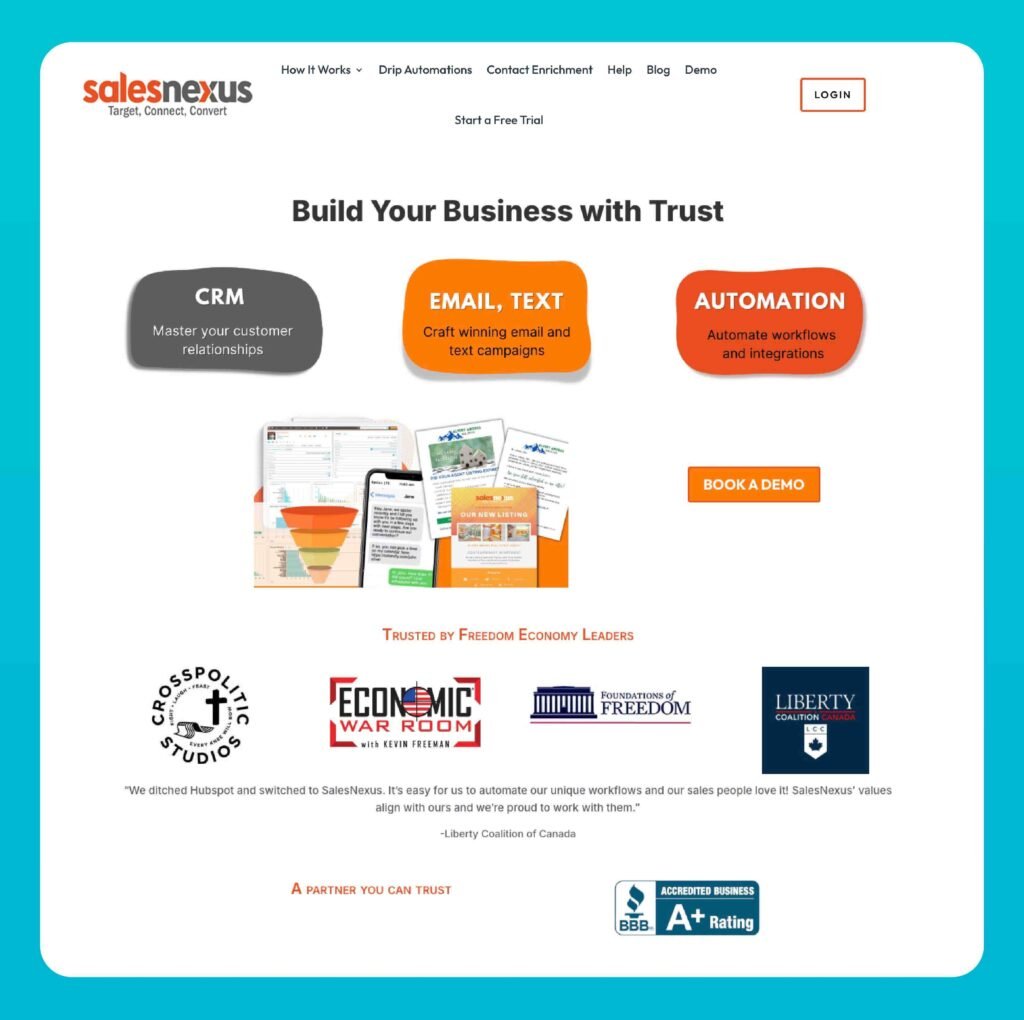
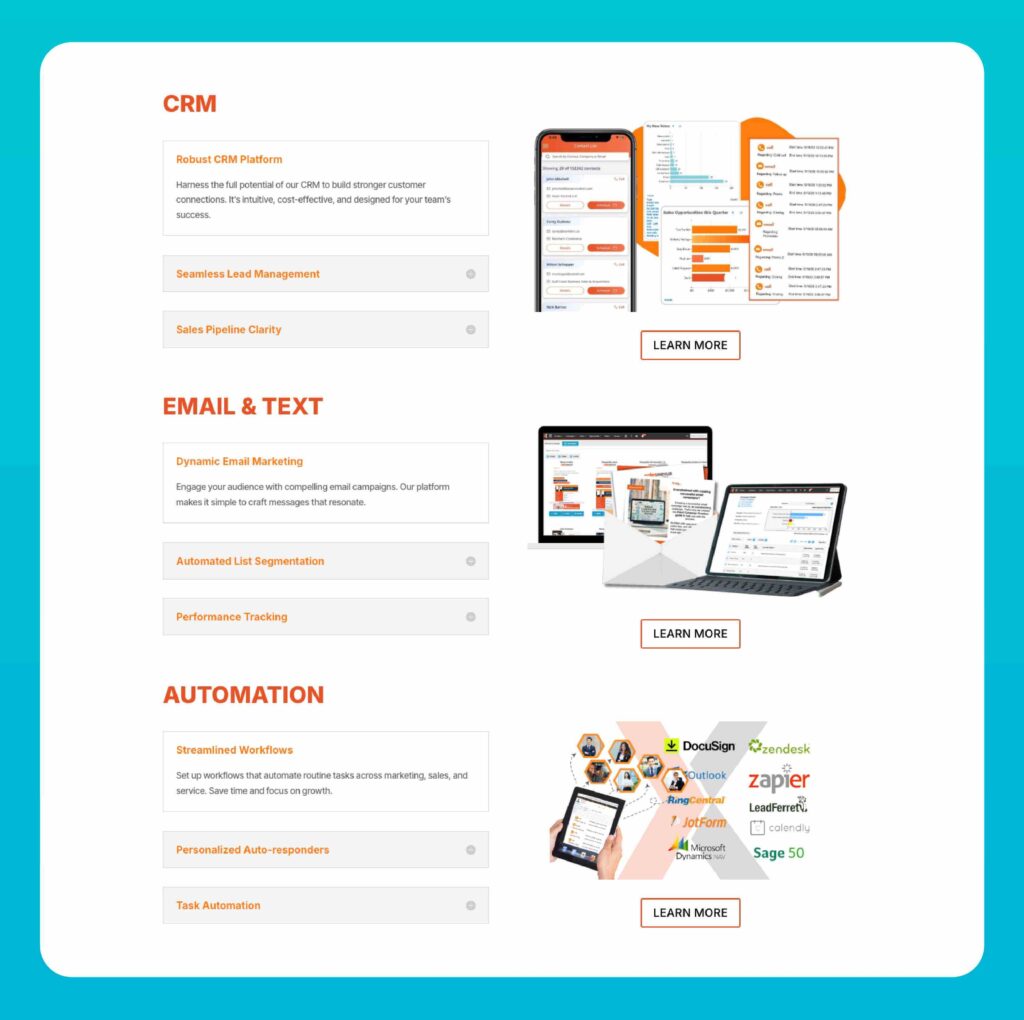
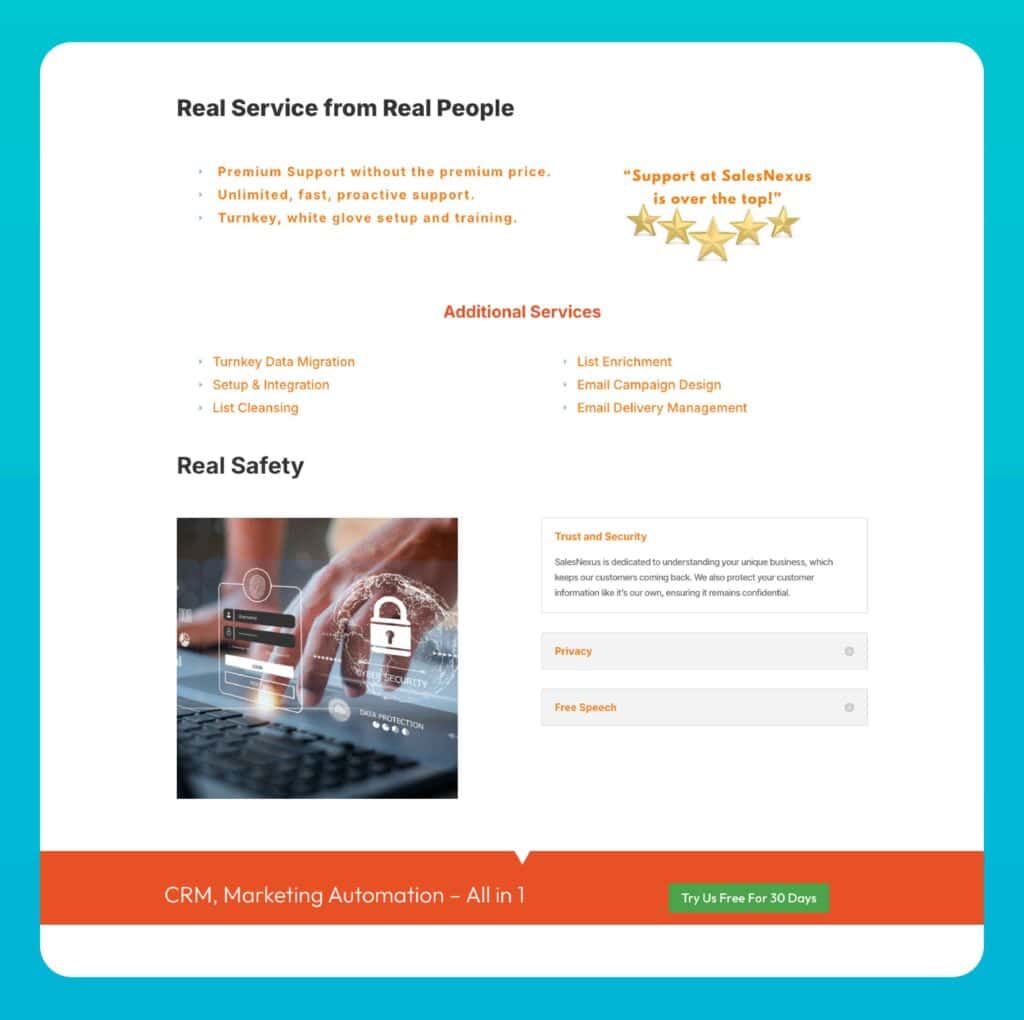
From Problem to Solution Awareness
Your landing page should guide visitors through two mental shifts:
- Problem awareness. Some visitors do not even realize they have a specific problem. For example, a meal-planning app prospect might just feel stressed about cooking daily without realizing disorganization is the root cause. Your copy and visuals should make them see the problem clearly.
- Solution awareness. Once the problem is clear, show them how your product provides the solution. In the meal-planning example, that means highlighting how your app organizes meals, saves time, and removes daily stress.
Avoid simply listing product features. Instead, focus on the value it delivers and how it solves the customer’s challenge.
No Distractions, Only Value
A focused landing page keeps attention on your main offer. That means:
- No sidebars
- No pop-ups
- Limited outbound links
Your call-to-action buttons should be visually distinct, easy to find, and repeated at least three times across the page.
For the best B2B SaaS marketing campaigns, a high-performing landing page is:
- Visually clean and simple
- Easy to navigate
- Full of social proof (testimonials, reviews, ratings)
- Focused entirely on your product’s solution
2. Use SEO and Tailored Content Marketing
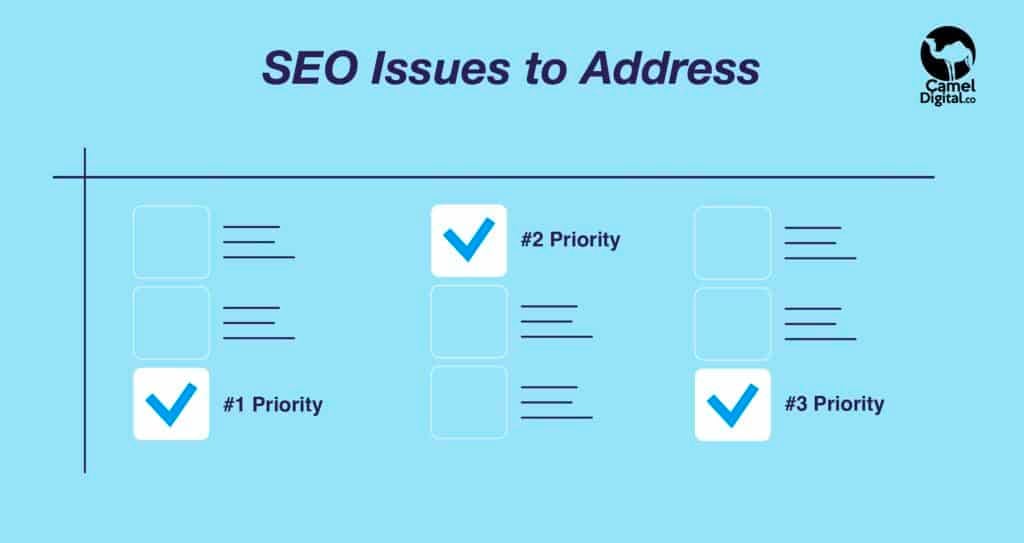
Before we get into SEO tips, it’s important to point out something. SEO in general and SEO within B2B SaaS marketing campaigns are not the same. The technology and tools may be similar, but the way you approach it should be different.
Here’s the thing. Most SEO agencies will run an audit on your SaaS website and hand you a long list of “fixes.” Taking the traditional “correct everything” approach is not the best move for B2B SaaS.
The smarter tactic is to focus only on the changes that will have the biggest impact on sales. For the best results in 2025, we recommend concentrating on these SEO goals first:
- Are you ranking for the top 1-3 keywords in your niche?
- Are your feature pages’ deep links ranked?
- Do your product pages have enough depth, and is their layout and content effective for SEO?
- Is your website fully mobile-optimized?
If these core SEO factors are in good shape, your site can still perform well even with a long list of minor SEO “errors.” This has been proven both in theory and in practice.
3. Spend Wisely on PPC Advertising
PPC and B2B SaaS marketing are still a strong combination in 2025. Paid ads let you appear for the search terms you want to rank for without waiting months to climb organic results.
But PPC is an expensive game, so you need to spend wisely. Randomly running campaigns without a targeted strategy can drain your budget quickly.
Working with a specialized SaaS PPC agency can help you focus your budget where it matters most, the keywords and audiences most likely to convert. After spending over $5 million testing different approaches, we at Camel Digital found these PPC strategies work best for B2B SaaS.
Bottom-Funnel Keywords
Bottom-funnel keywords are the “low-hanging fruit” of PPC because they target people who already know they need a solution. These search terms are very specific and often include the product type and industry, such as “CRM for eCommerce,” “Digital Marketing for SaaS,” or “Project Management Software for Enterprises.”
The cost per click (CPC) for these terms is often higher, sometimes 2 to 3 times more than broad keywords, but the conversion rates are worth it. This is because the searcher is already deep in the buying process, making them far more likely to take action quickly.
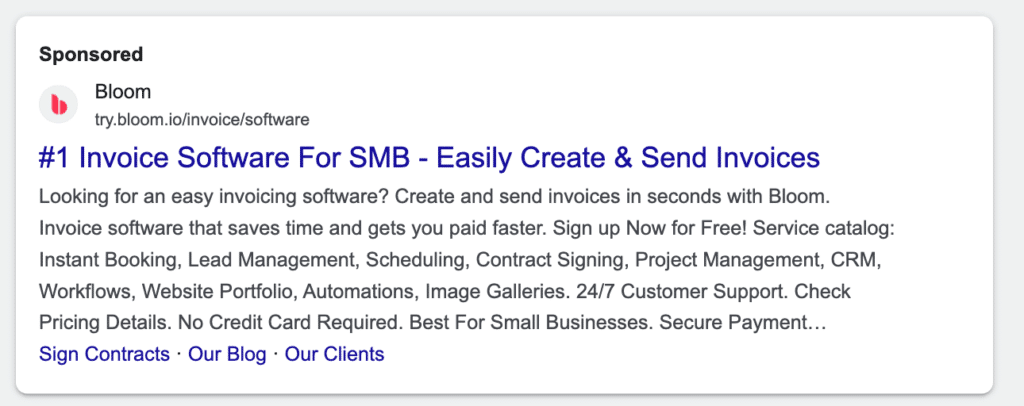
Bidding on Competitor Keywords
This approach targets people who are searching for alternatives to your competitors’ products. For example, if you sell a CRM platform, bidding on “HubSpot alternative” puts you in front of prospects who are actively looking to switch providers.
The value here is that these users are not just aware of the problem, they’re also aware that solutions exist and are in the final stage of decision-making. This makes them some of the most qualified leads you can get from PPC.
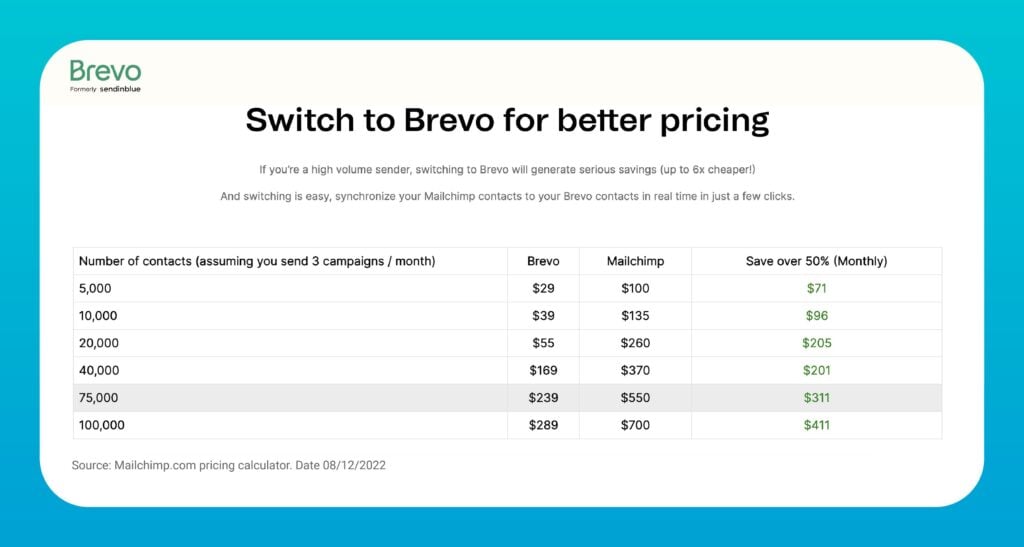

Retargeting Bottom-of-Funnel Users (RLSA)
Remarketing Lists for Search Ads (RLSA) allow you to show search ads specifically to people who have already visited your site or engaged with your brand in some way.
Here’s how it works:
- A visitor comes to your site through any channel (ads, organic search, social media).
- You add them to a remarketing list in Google Ads.
- When they later search for relevant keywords, they see your ad again, but now you can tailor the message knowing they’re already familiar with your brand.
When combined with bottom-funnel keywords or competitor bidding, RLSA ensures you’re staying top-of-mind when the lead is ready to make a purchase decision.
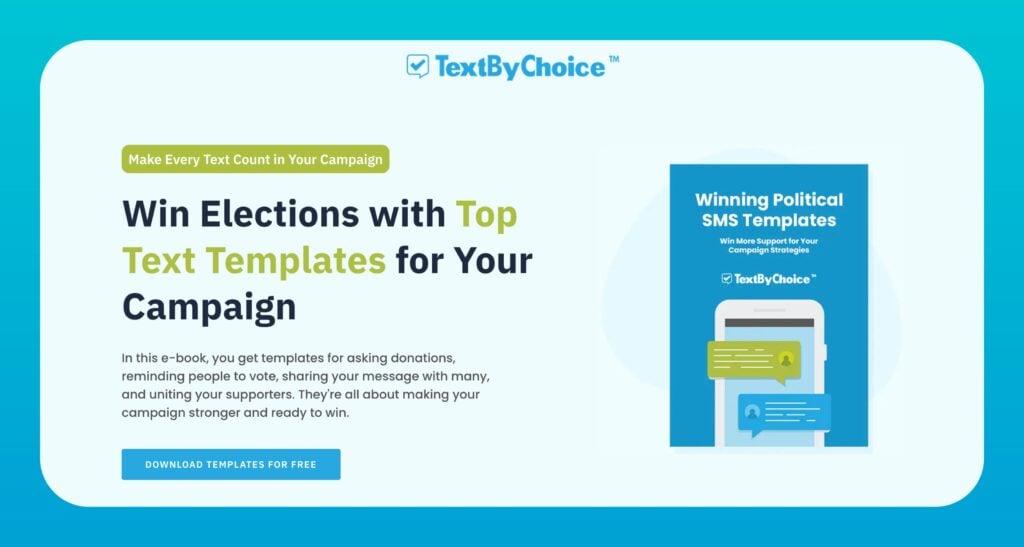
Targeted YouTube Ad Campaigns
When high-intent keywords are too expensive on search, YouTube can be a cost-effective way to reach the same audience. The platform allows you to show highly relevant ads to people who fit your buyer persona, often for a fraction of the CPC you’d pay on Google Search.
For example, one client, a CRM software provider, faced $30+ CPC for “CRM software” in search ads. Competing directly with giants like Zoho, Salesforce, and Keap wasn’t realistic for their budget. Instead, we built a laser-targeted YouTube campaign designed to reach those same prospects earlier in their decision-making process, but at a much lower cost.

We set up the campaign using:
- Competitor brand names as custom intent audiences.
- Relevant product keywords as targeting criteria.
- The “Product & Brand Consideration” campaign type to encourage engagement rather than pure awareness.
This targeting approach ensures your ads are served to people who are already interested in your type of product, while lowering acquisition costs and building familiarity with your brand.
The Hook–Story–Offer Format
We highly recommend the Hook-Story-Offer format, like what we did here for the SalesNexus video:
- Hook: Start with something attention-grabbing. Example: “Did you know that 50% of sales CRMs fail, costing teams thousands for zero benefit?” This resonates with prospects who have had disappointing CRM experiences.
- Story: Share a credible, relatable background. In our case, the SalesNexus CEO explained how they’ve helped thousands of teams sell smarter since 2002.
- Offer: Present value propositions and features tied directly to the hook and story, then encourage viewers to take action, like signing up for a free trial.
YouTube serves these videos to large, targeted audiences repeatedly. Users who watch at least 30 seconds count as a view, some will convert right away, while others can be retargeted later via search and display ads.
LinkedIn Ads
LinkedIn remains one of the most effective platforms for reaching decision-makers. You can target employees at companies you want as clients, filtered by job title, company size, industry, and more.
While CPC on LinkedIn is usually higher than other platforms, the precision targeting often justifies the cost. You’re paying to reach exactly the right people, which improves lead quality and conversion rates.
Tips for stronger LinkedIn ads:
- Clearly state your product’s value proposition.
- Use strong visuals and concise ad copy.
- Include a clear CTA that leads to your landing page.
- Run A/B tests to identify top-performing creatives.
When High-End Keywords Are Too Expensive
If bottom-funnel keywords are out of budget, focus on middle- or top-of-funnel searches instead, then nurture those leads. Prospects searching for those keywords are either unaware or just beginning to look for a solution. So, they have the problem but are not sure what the solution is. Your goal is to show them the solution.
For example:
- Target terms like “bulk emailing” instead of “bulk emailing software.”
- Offer a lead magnet (eBook, checklist, demo video) in exchange for contact details.
- On the thank-you page, prompt the lead to book a demo, sign up for a trial, or follow you on social media.
This builds a list of prospects you can continue marketing to through email, remarketing, and retargeting until they’re ready to buy. If your budget is limited, this is the most efficient way to generate leads without breaking the bank.
When Competition Is Overwhelming
Some industries have players so dominant that outranking them for top keywords is nearly impossible, at least in the short term. For example, trying to beat HubSpot for “marketing software” can be unrealistic for new entrants.
In these cases, Camel Digital often shifts budgets to YouTube ads or other channels where competition is less intense. The goal is to build brand awareness and trust before returning to high-competition search terms later.
4. Appear on Product Hunt and Other Review Websites
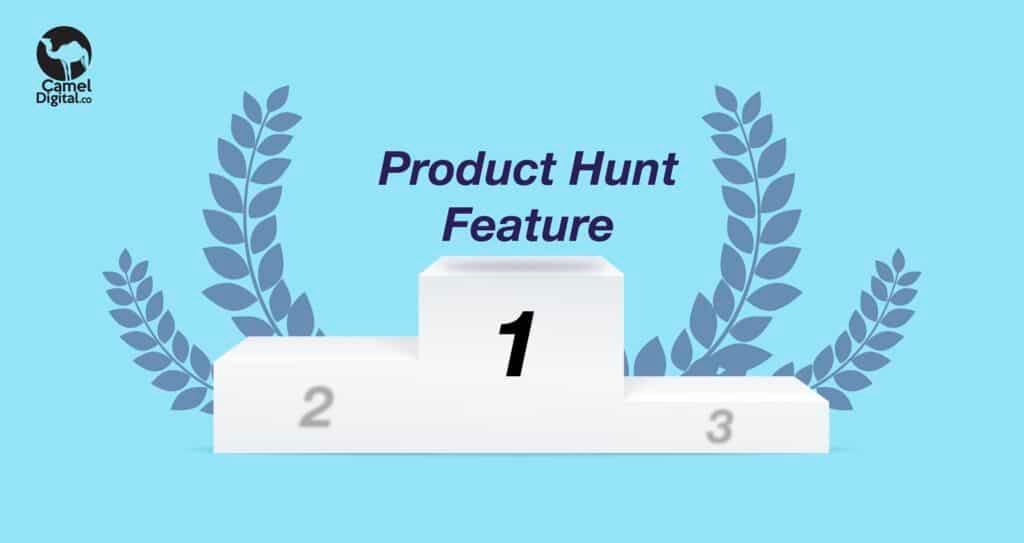
There’s a reason people talk about the “Product Hunt Effect.” Appearing on this top SaaS-focused platform can give your product massive exposure, leading to a surge in website traffic and sign-ups.
SaaS companies featured on Product Hunt have reported up to a 300% rise in daily active users and a 500% increase in website visitors right after their launch. This means when your SaaS product is ready, you must concentrate on reserving your spot on Product Hunt right away. In 2025, the audience there is still actively looking for new software to try, and the platform’s community trust makes it easier for them to give your solution a chance.
Your marketing strategy should also include other review platforms like G2, Capterra, and Trustpilot. These sites attract a high volume of decision-makers searching for B2B SaaS solutions. By collecting positive reviews on them, you not only gain credibility but can also improve your ad performance and ROAS for SaaS over time.
5. Invest in the Right Content
You don’t need to publish only SEO-polished, in-depth whitepapers (although those can be valuable). What matters most is creating content that genuinely answers your audience’s questions and solves their problems.
Helpful and informative blog posts, eBooks, webinars, or podcasts can attract potential customers to your website and convert them into leads. Your website copy should be clear, simple, and focused on moving interested visitors closer to becoming customers by highlighting the product’s most relevant features and benefits.
High-quality demo videos are especially effective. Buyers want to see exactly how a SaaS product works before committing. Make sure your videos are visually appealing, easy to follow, and clearly show how your product solves a problem or improves a process.
The rule is simple: the more real value your potential customers get from your content, the more likely they are to trust and invest in your product.
6. Be Active on Social Media
SaaS products can be technical, and at first glance, they may not seem like the most exciting thing to promote on social media. On top of that, reaching business customers here isn’t as straightforward as it is in consumer markets.
The good news? Your B2B SaaS social strategy doesn’t need to involve posting multiple times a day or jumping on every trending topic. Instead, focus on creating well-crafted content that speaks to business audiences, people who value real benefits and clear facts.
It also shouldn’t be all about your product. Mix in industry news, business tips, and even the occasional relevant meme to keep your feed alive.
For example, Confluent, a native Apache Kafka SaaS provider, often shares expert interviews on its channels. One live interview featured the VP and senior software engineer of Wealthsimple, explaining how they use Confluent to handle large amounts of data and build real-time applications.
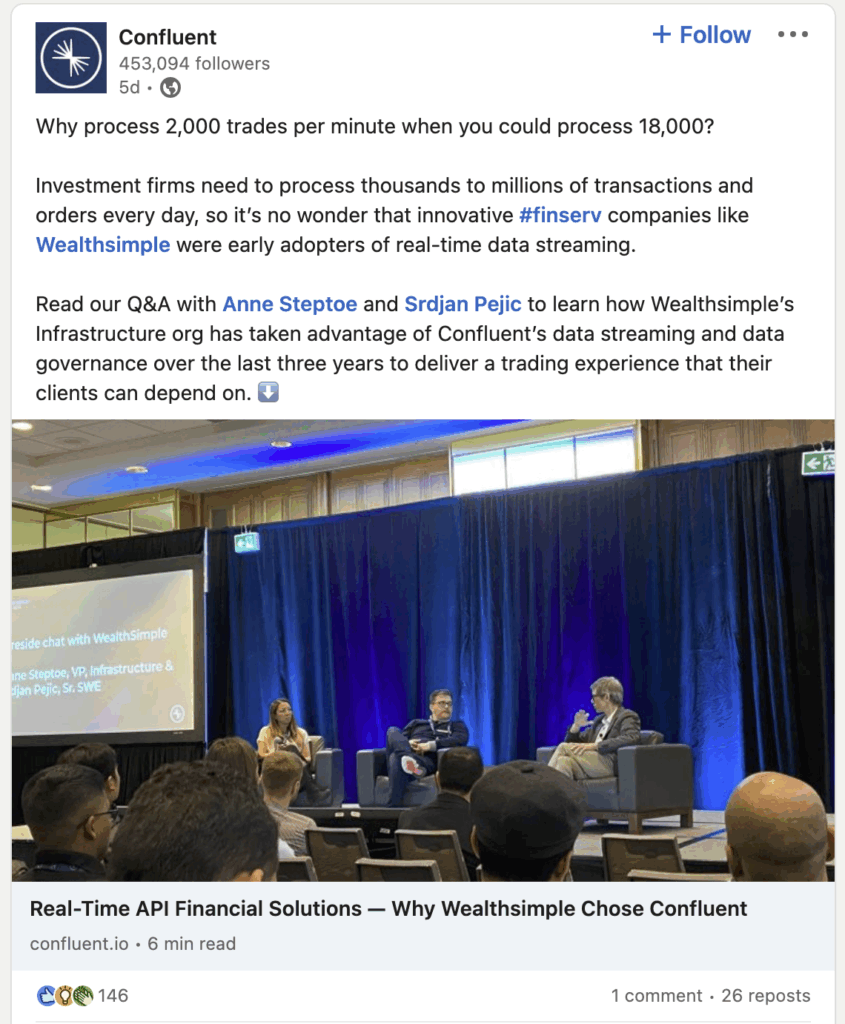
Other ideas for social media content include:
- Hosting webinars or live chats with industry experts.
- Sharing case studies and success stories of how your product has helped businesses improve their processes
- Broadcasting a live product demo so potential customers can see it in action.
When done right, social media can attract high-quality prospects and keep your brand visible in the spaces where your audience spends their time.
7. Build a Strong Community Around Your SaaS
Be friends with your customers. Your target business customers love networking, and they consider timely and efficient communication the most important parts of building a relationship.
That’s why building a strong community around your SaaS is crucial for success in B2B marketing. There’s no single right way to do it, what matters is consistent engagement and making your customers feel heard.
For example, Semrush is pretty active on LinkedIn comments often more active than your most extroverted friend on TikTok. They regularly respond to comments with valuable insights, starting real conversations and building relationships with potential customers.
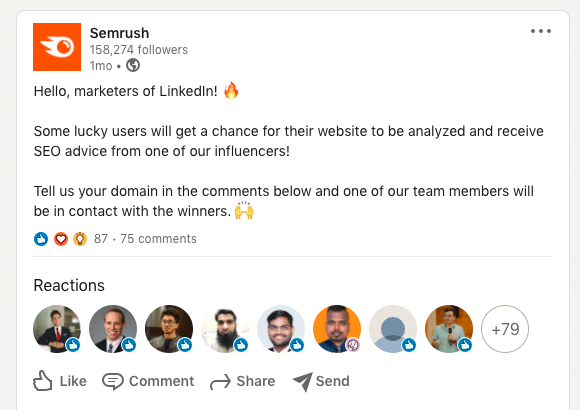
You can even mention them on LinkedIn, and you’ll likely get a quick, in-depth response. This is a perfect example of how B2B SaaS marketing teams can use social media platforms not just to broadcast content, but to connect directly with people.
Imagine having friendly, helpful exchanges with the SaaS you’re considering for your business. Wouldn’t that make you more confident about choosing their product?
8. Have an Affiliate Marketing Program in Place
Referral programs, especially two-sided models, can drive exponential growth for SaaS businesses. Dropbox, Trello, and PayPal are just a few examples of companies that have built a significant part of their B2B SaaS marketing through affiliate or referral programs.
The idea is simple: offer rewards to both the person making the referral and the new customer they bring in. These rewards can be free upgrades, extended trial periods, or even monetary bonuses.
For instance, Dropbox gives both the referrer and the referee extra free storage space, which motivates people to share the product. Trello offers both parties a month of Trello Gold, their premium project management tier, for every successful referral.
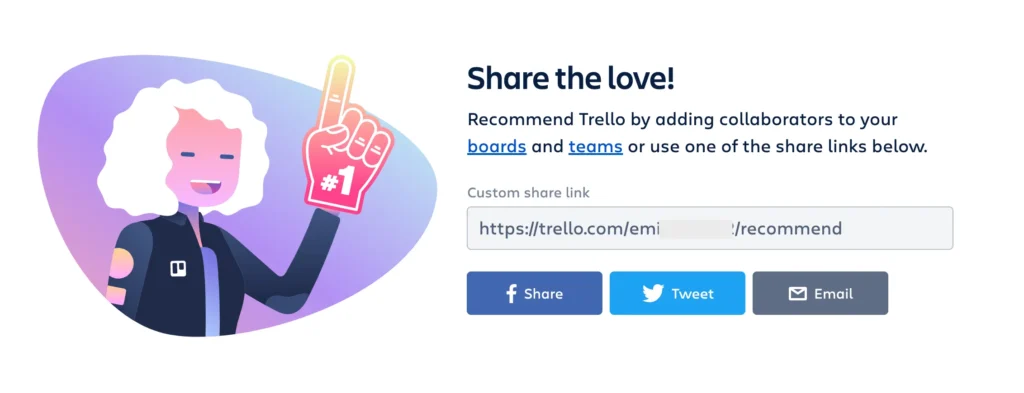
It’s a win-win situation: your SaaS gains new customers, your existing customers get rewarded, and potential customers hear about your product from a source they trust. This is one of the lowest cost-per-acquisition strategies you can use, because your customers essentially become your marketing team, you just need to give them the right incentives.
9. Design an Easy Flow for Sign Ups
No customer wants to spend hours figuring out how to sign up for a service or use a product. Long forms, multiple verification steps, or unclear instructions can easily drive potential customers away.
Many successful SaaS companies have streamlined their signup flows to make the process as quick and smooth as possible. A few proven tips include:
- One action per screen. For example, ask for an email address on one screen, then a name on the next. Breaking it into steps makes the process less intimidating.
- Minimal forms and pre-filled fields. Don’t make users re-enter details like name or email multiple times.
- Delay email verification. Even small steps can cause drop-offs early in the process. Let users start using your product before confirming their email.
- Show progress indicators. Let users know how far along they are in the signup process to encourage completion.
- Offer alternative signup methods. Social media or Google account integration can make signups faster and more appealing.
If you need additional customer data, consider a pro-signup flow: let users sign up quickly first, then prompt them to share more information afterward. For example, you might ask about their profession, use case, or how they found your product, while offering an incentive like a discount or bonus feature for completing these extra steps.
This approach benefits both sides: customers get to try the product immediately, and your company still collects valuable insights that can help improve targeting and conversions.
10. Have Comprehensive Product Demos
According to Gartner, personalized product demonstrations remain one of the top 10 most influential content types for purchase decisions. It makes sense, we’re all more likely to invest in something when we see exactly how it works for us.
A well-executed product demo is one of the simplest yet most effective tactics for increasing conversions. It shows the value of your product in real time and helps potential customers visualize how it can solve their specific challenges.
Whenever possible, have someone from your product or customer success team conduct the demo. Tailor the walkthrough to the prospect’s unique needs and pain points, this demonstrates that your company is genuinely committed to solving their problems.
In fact, Demos don’t just benefit the customer. They also help ensure that people use your product as intended, which can reduce churn and improve long-term satisfaction.
Here are some great SaaS product demo videos to inspire you.
11. Invest in Having Positive Customer Reviews and Feedback
Actually, it’s not just about collecting positive reviews; it’s about making them visible. Many SaaS companies have glowing ratings buried in internal surveys or niche forums, but if potential customers can’t see them, they won’t help your marketing.
This is a huge mistake because customer reviews and feedback can be a powerful marketing tool. They provide social proof that your product is reliable, valuable, and trusted by real businesses, which makes prospects more confident in their decision to buy.
One of the most effective B2B SaaS marketing tactics is to feature reviews prominently:
- A testimonial section on your homepage.
- A dedicated reviews or case studies page.
- Quotes in email campaigns.
- Highlighted snippets on social media.
And don’t be shy about asking for feedback, satisfied customers are often happy to share their experiences. When used strategically, reviews can become a conversion driver in every stage of your marketing funnel.
12. Have Truly Attractive Deals and Offers
There’s an old saying: great products are the best marketing. The more your offer is tailored to your target audience’s needs, the fewer B2B SaaS marketing “tricks” you’ll need to use.
A strong deal in B2B SaaS usually combines three things: it solves a real problem for your potential customers, it’s better or more affordable than the competition, and it has a clear, compelling value proposition.
- Extended free trials or demos. Go beyond the standard 14-day trial. Business customers often need more time to test and evaluate software before deciding. Since one month is a common invoicing cycle for B2B SaaS, offering a 30-day trial gives prospects the chance to fully experience your product’s value.
- Bundling. Offer multiple products or services together at a discounted rate. This can encourage larger purchases, increase revenue, and open opportunities for upselling or cross-selling to existing customers.
And yes, strictly avoid the fluffy cliches like “Once in a lifetime offer” or “Limited time only!” that are often seen in consumer marketing. Business people are more skeptical and are looking for real value, not just flashy marketing slogans.
13. Make Sure Your SaaS Works With Popular Tools
The last B2B SaaS marketing strategy is to build easy integrations with the tools that your target audience is already using. Because, you know, switching to new software can be a tough sell if it forces teams to change their entire workflow or abandon tools they rely on daily.
When your software integrates seamlessly into their existing setup, it feels less like a disruption and more like the missing piece they’ve been waiting for.
If you’ve invested in creating these integrations, make sure they’re not a hidden feature. Highlight them clearly on your website, in product descriptions, and during demos so prospects immediately see how easy it will be to adopt your solution.
A B2B SaaS Marketing Agency’s Advice
Learning From Every Investment
When you spend $100 on B2B SaaS marketing, you usually learn something from it. Maybe the campaign doesn’t work out, or maybe it brings in a few customers; either way, it’s data you can use.
Invest $1,000 or more, and you double the insights you have to work with. You start to see which customer segments respond best, what messaging clicks with your audience, and where your money is best spent.
Now imagine the learning curve after running five-figure campaigns across different channels and strategies; seeing what rises, what fails, and which combinations deliver consistent conversions. That’s the experience we’ve built at Camel Digital, a B2B SaaS marketing agency specializing in PPC campaigns that sell, convert, and scale.
If any of the strategies above caught your attention (we assume all of them), contact us!
What Happens When We Work Together
Market Research and Account Audit
We start with a deep dive into your current marketing setup, market conditions, and competition. You’ll get a detailed list of account improvements backed by competitor insights, often revealing opportunities you didn’t know were there.
Starting From the Bottom Funnel
We’ve mentioned it before: bottom-funnel marketing reaches buyers who already know their problem and are actively looking for a solution. Targeting them first often leads to faster conversions and higher ROI, even if the audience is smaller.
Ongoing Optimization of the Campaigns
No two businesses follow the same path. Market shifts, seasonal changes, and new competitors all bring fresh challenges. That’s why we continuously optimize based on real-time performance data, keeping your campaigns sharp and effective.
Final Thoughts
Standing out in the crowded B2B SaaS market is tough. Competition grows every year, and it takes a focused, strategic approach to truly make an impact.
At Camel Digital, our work is based on learning, testing, and refining B2B SaaS marketing strategies not guesswork. With the right strategy, your SaaS product can cut through the noise, reach the right audience, and deliver measurable results.
Let’s make your B2B SaaS product the one your market remembers.
